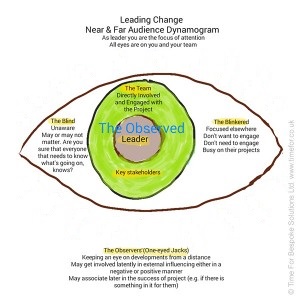Some of us will have experienced the scenario when one morning your boss calls you in for a 121 chat, to announce that their boss has suggested that you are the ideal candidate to take ownership of this big new important project, and drive forward the idea through to its birth. Not only are you now in the spotlight as being the person upon whom the responsibility lies for its success (hopefully!) or its failure (this isn’t an option – don’t go there), but things now have to be seen to be gathering pace. At last you are being given the opportunity to prove yourself in a position of leadership and all the responsibility for change management that comes with it.
Within days, life has changed dramatically. What were previously your priorities have now sweepingly been re-prioritised. If you are lucky they are now sitting on someone else’s desk! You have been fully briefed, critical deadlines set, resources and a support team are in the process of being assigned, and if you are smart (assuming that someone has ever told you anything about it) you will already be formulating a Key Stakeholder Management Strategy. After all, beyond your immediate team you need to fully understand who the key influencers are and at what level could they have an impact on progress (positive or negative). Building an effective rapport with this group and making them aware of the project goals and aspirations, in order to gain their support, is what you are aiming for. Failing that, at least having them take a neutral position, as opposed to being against the idea (yes, there is nothing worse than a key stakeholder, with a high level of influence and a lot of power, working against you behind the scenes!) is your fall back point.
So there it is, all is good to go and you and your team quickly get on with the task at hand. Without debate there is a vast range of core skills required in leading any large project, as well as, of course, the essential technical knowledge that would need to exist within your team. But the one aspect I would like to focus on in this blog, is that of understanding the team and audience dynamics that may be occurring in association with your leadership role and the project overall. To demonstrate this I have quickly created a dynamogram (see picture) of the various participants (and for that matter, non-participants) that could exist. I am not suggesting that what’s been created here covers every scenario: it doesn’t. It is merely one view of the world, as to where a leader sits when driving forward changes or new ideas within an organisation. So take a look at what’s been produced here and consider it in relation to the various projects you are involved with and also those that are happening around you. For each of the key changes that are occurring today in your business you may find that where you are positioned in the model differs substantially from project to project. Are you happy where you’re at? If you are ‘Blind’ or ‘Blinkered’ you may want to re-assess your position!

